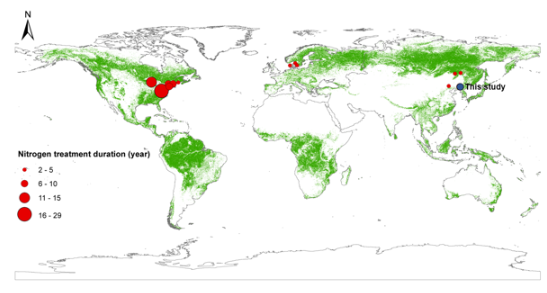Since the industrial revolution, human activities have greatly increased reactive nitrogen (N) emissions to the atmosphere, resulting in an increasing global atmospheric N deposition. Existing stimulated N deposition experiments are carried out mostly in forests in Europe and the United States with low background N deposition, and the treatment durations are often short. In China, N deposition levels has been shown to remain steady in the last ten years at a relatively high level. However our understanding of how tree growth responds to long-term N addition in forests in northeast China is limited. Furthermore, photosynthetic carbohydrates allocation among different tree organs is an important factor determining forest carbon (C) sink capacity. Nitrogen deposition may affect the allocation of photosynthates, and thus affect forest C sink capacity.
The research group led by Prof. FANG Yunting from the Institute of Applied Ecology of the Chinese Academy of Sciences conducted stimulated N deposition experiments in the larch forest and the mixed forest in the Qingyuan Forest, National Observation and Research Station. They monitored the responses of tree growth and litterfall production during 2014-2021 to detect N effects on tree growth and C allocation. Besides, they also did meta-analysis on tree growth and C allocation data from other stimulated N deposition experiments in temperate and boreal forests worldwide to examine if there exist general effects of N deposition.
Eight years of simulated N deposition (50 kg N ha-1 yr-1) increased total biomass increment by 24% in both the larch and the mixed forests. The C-N response of total biomass was 11 and 10 kg C per kg N in the two forests, respectively (Figure 1). Nitrogen additions increased total litterfall production (9%) and foliage litterfall production (14%) in the mixed forest, and the positive effect decreased with treatment time. Nitrogen additions increased the ratio of woody biomass increment to foliage litterfall production (by 34% in the larch forest and 8% in the mixed forest) in both forests, indicating stronger promoting effect of N on woody biomass increment than on foliage litterfall production. By integrating tree growth data from N addition experiments in other temperate and boreal forests worldwide, they found the similar pattern as in Qingyuan forests: simulated N deposition increased woody biomass increment and foliage litterfall production by 24% and 9% on average. These results implied that N deposition promotes tree growth and may shift tree aboveground C allocation towards woody tissues over foliage in temperate and boreal forests around the world, which is conducive to enhancing forest stable C sink under the context of climate change such as global warming.
The study entitled “Effects of nitrogen deposition on carbon allocation between wood and leaves in temperate forests” was published in Plants, People, Planet.
This work was financially supported by the National Key Research and Development Program of China (2016YFA0600802), K.C. Wong Education Foundation, Liaoning Vitalization Talents Program, the National Natural Science Foundation of China (31901134 and 31770498), the Strategic Priority Research Program of the Chinese Academy of Sciences, and the Science and Technology Program of Shenyang.

Fig.1 Responses of total biomass increment and total litterfall production to stimulate N deposition during 8 years of N treatment (from 2014 to 2021) in the larch (a, c) and the mixed forest (b, d) in the Qingyuan forest station. Inserts are the response ratios of the variables during 8 years of N treatment (year)(Image by ZHUFeifei).

Fig.2 Distribution of 25 N addition experimental sites in temperate and boreal forests around the world(Image by ZHUFeifei).

Fig.3 Response ratio (a, c, e) of aboveground woody biomass increment, foliage litterfall production, and the ratio of aboveground woody biomass increment to foliage litterfall production to N additions in temperate and boreal forests around the world. Trends of these response ratios to N additions over time were also given (b, d, f) (Image by ZHUFeifei).
Contact
YUE Qian
Institute of Applied Ecology, Chinese Academy of Sciences
Tel: 86-24-83970324
E-mail: yueqian@iae.ac.cn
Web: http://english.iae.cas.cn